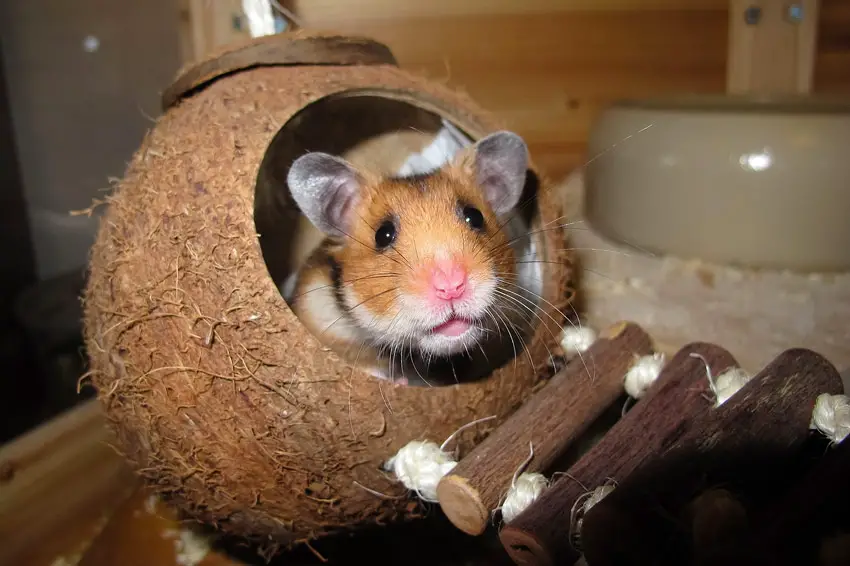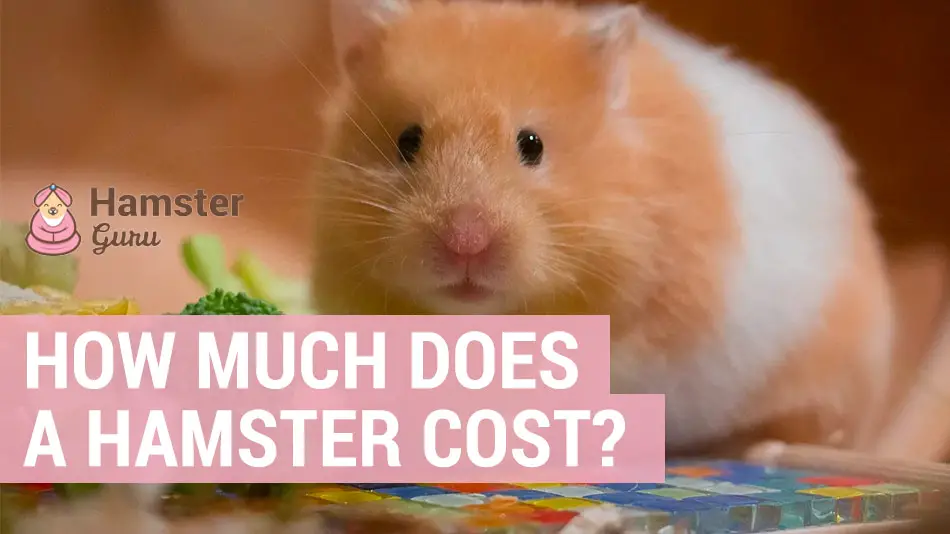Although in comparison to other pets purchasing a hamster is considered a cheap option, the ownership and daily living costs can soon mount up. As first time hamster owners we were conned into buying every gadget going but over the course of time have come to appreciate and understand what are considered to be hamster essentials.
How much does it cost to care for a hamster?
Although a hamster shouldn’t cost any more than $25 to purchase, its ongoing care can add up. Essentials such as a hamster cage, wheel and toys, plus reoccurring maintenance costs including bedding & food can reach $885 over a hamster’s lifetime.
Below we give our top tips on the must have hamster accessories and explain ways in which you can look after your furry friend and still save money.
Where should I buy a hamster?
Pet stores such as PetSmart and Petco are by far the cheapest option when looking to buy a hamster. These large commercial pet stores stock a variety of different breeds, from Russian to Roborovski, Syrian and even Winter Whites; all at an affordable price. A hamster from these types of stores will cost between $15-20, although a teddy bear hamster may cost a little more as they are highly sought after thanks to their cute and cuddly appearance.
If you are looking for a more ethical option and would prefer to purchase your hamster from a reputable breeder, then you will need to do your research. Private breeders will often charge more than the average pet store because they are specifically bred to meet stringent breeding standards. This does, however, often mean that when you take your hamster home, they are happier and healthier from the outset.
If you are wanting to simply give a hamster a forever home and are not concerned with the breed or color, then when not consider adopting? Visit a local pet shelter and rescue a hamster in need as these are often offered for free when going to a good home. Just be aware that you may not always be given the background information, on where they came from or previous owners and this could impact your hamster’s behavior towards you.
The true cost of buying a hamster
Although buying a pet hamster is relatively inexpensive, it is the ongoing costs of caring for your hamster that represents the real expense.
To begin with you have the initial outlay of purchasing the cage, wheel, hideout and toys followed by the ongoing costs of bedding, substrate and food. And, if your hamster is anything like our hamster Oscar, then he will be completely pampered with his every whim catered for.
According to the economic publisher Kiplinger It is estimated that in the first year of hamster ownership you can expect to spend around $345 with a further $260 annually on care costs. Therefore, if your hamster lives to see the ripe old age of 3yrs, it is likely that you will have paid out around $885 in care – and that’s providing they remain healthy!
Vet bills are the most expensive part of owning any animal, and although you don’t have to take your hamster to the vet regularly for vaccinations or spaying (unless for medical reasons), you should see a vet if your hamster becomes sick or injured. The price you may pay for a visit to the vets is likely to vary as much from city to city and state to state as it is for the diagnosis say we would recommend having between $100-200 set aside for hamster vet costs and emergencies.
How much does it cost to euthanize a hamster
If your hamster becomes terminally ill, then the only option left available to you can often be the most heartbreaking. Although an owner never wants to have to make a life or death decision, sometimes putting your hamster to sleep is the only way to stop their suffering. This procedure is completely painless for your hamster but does need to be carried out by a professional vet.
As with any vet bills, the cost will vary, but you can expect to pay around $40+ for hamster euthanasia.

How much does hamster food cost?
Pre-packaged muesli or pellets bought from your local pet store or online offer a great source of nutrients and minerals for your hamster, however small quantities of fresh fruit, vegetables and herbs offer a great way to supplement their diet too.
Wild hamsters forage for their food at night and are not particularly fussy, so resist the urge to go out and buy lots of fancy vegetables and give your store cupboard greens a scrub instead. Hamster particularly love broccoli, cabbage, cauliflower, chicory, kale, spinach, sweep peppers, cucumber and carrots. Be mindful, however, that some fruit and vegetables are high in natural sugars so should not be given on a daily basis. For full information on what to feed your hamster, see our informative guide.
When you visit the hamster section of your local pet store you will be presented with rows of tasty hamster treats. But beware before buying these, as they are not always considered healthy for hamsters. Often laden with sugars and syrups a more nutritious and cost effective option is to make some hamster muffins or cookie snacks yourself. Please see this article for some homemade hamster treat recipes.
How much is a hamster cage?
One of the biggest outlays you will make as a responsible hamster owner is to invest in a good cage, but make sure you get the correct size from the start. We made the mistake of buying a starter kit and within weeks Oscar had outgrown his habitat.
Ideally you should only consider hamster cages that are a minimum of 24 inches by 12 inches and at least 12 inches tall – especially if you have a Syrian, as these are the largest hamster breed growing to around 4-7 inches in size.
In addition to getting the specifications of your hamster’s cage right, you should also consider their environment, health and wellbeing. This should save you money in the long run, as you will not need to constantly change, adapt or update their cage as your hamster grows and develops in personality.
Make sure they have plenty of ventilation, are easy to clean out and that they are made from durable materials. A good, sturdy cage will cost between $50-$100. If you are looking for recommendations or want to do some research before purchasing, check out our blog on best hamster cages.
Alternatively, if you are thrifty and into DIY, why not make your own hamster bin cage. Bin cages are cheap to make in comparison to the prefabricated ones that you can buy at the pet store, which means money for you to spend on pampering your pet hamster instead.
If you are interested in how to make a hamster bin cage, take a look at our step by step guide.

What do you need to look after a hamster?
As you can see there are quite a lot of basic items that you will need to purchase in order to care for your hamster each day. But don’t let your head be turned by the clever marketing ploys used by pet stores – instead be creative and come up with some homemade solutions of your own.
Below we have listed the cost of other hamster essentials that you will need:
Bedding
Hamsters are burrowers by nature, so you need to ensure that you have enough bedding for them to hide. A typical Syrian hamster will need a layer of around 6inches and paper-based bedding is best.
Food dish
Although your hamster may scoop up and store food in its cheeks, a simple food dish is not expensive. Our top tip is to go for the cheaper plastic versions as the china or porcelain ones may look pretty but do the same job. They are also heavier so could cause injury if your hamster tips them over all the time – as our hamster Oscar always does.
Alternatively, you could try this tip-proof ergonomic hamster bowl.
Water bottle
Whether you choose plastic or glass, hamster water bottles should be filled up daily and are inexpensive.
Hideout
All hamsters like to retreat to a safe place and depending on the type of material these are made from.
Chew toys
In order to keep your hamsters’ teeth in tip top condition it is important that they have something to grind their teeth on. You shouldn’t ever need to have their teeth trimmed providing they are well maintained. We have tried many different toys and although Oscar prefers the wooden variety, he would much rather have a cob of corn or a carrot. Much more effective and tastier too.
Toys
Hamsters need brain stimulation and are incredibly active (especially at night). Therefore tunnels, tubes and bridges are great for them to run around in. These cost around $5-$10 depending on the type of material they are made from. My kids love to make their own versions using toilet roll holders and empty boxes.
Wheel
Hamsters need to burn off energy and just love running around in a wheel. The cost of a wheel will vary depending on the size required. Therefore, the cost of a wheel for a Russian Dwarf hamster is going to be cheaper than a wheel for a Syrian but should cost no more than $40 max.
Exercise ball
Hamster needs exercising outside of their cage and the cheapest way to do this is to handle them. There may, however, be times when you don’t have time or your hamster needs to be kept occupied whilst you clean their cage, and so an exercise ball is a good solution. These free spinning hamster balls cost around $20 depending on the size you purchase.
Carrier
This may not be essential straight away, but it is good to have something that you can carry your hamster in if you ever need to take it out of the house – for example to the vets. A basic hamster carrier costs around $10-$12 (although we tend to make our own versions with boxes we already have around the house).
Another top tip is to look out for the discount bins at pet stores or special offers advertised online, as you can save many more dollars this way.
Conclusion
Although the initial startup costs of buying a hamster may seem like an expensive purchase, hamsters are still one of the cheapest pets around. Plus, they are easy to care for too as they only rely on us for their basic needs such as food, water, shelter and handling.
We would thoroughly recommend that you invest in a pet hamster both in a monetary and emotional way, as they can bring such joy to families whilst teaching us many things about looking after animals.
Remember, you don’t have to be lulled into buying all the bright and colorful accessories and toys, as your hamster will be just as happy with homemade alternatives.

